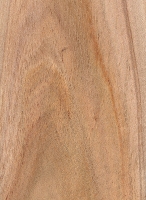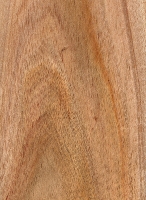 |
Common Name(s): Shittim, Red Acacia, Shittah Scientific Name: Vachellia seyal (syn. Acacia seyal) Distribution: Northern tropical Africa Tree Size: 25-50 ft (8-15 m) tall, 1-2 ft (.3-.6 m) trunk diameter Average Dried Weight: 41 lbs/ft3 (660 kg/m3) Specific Gravity (Basic, 12% MC): .53, .66 Janka Hardness: 1,150 lbf (5,110 N)* *Estimated Janka hardness based on specific gravity Modulus of Rupture: 14,220 lbf/in2 (98.1 MPa) Elastic Modulus: 1,550,000 lbf/in2 (10.69 GPa)* Crushing Strength: 6,700 lbf/in2 (46.2 MPa)* Shrinkage: Radial: 3.6%, Tangential: 5.8%, Volumetric: 9.5%, T/R Ratio: 1.6* *estimated values based on strength/shrinkage groups found in African Timbers |
Color/Appearance: No data available.
Grain/Texture: No data available.
Endgrain: No data available.
Rot Resistance: No data available.
Workability: No data available.
Odor: No characteristic odor.
Allergies/Toxicity: Besides the standard health risks associated with any type of wood dust, no further health reactions have been associated with Shittim. See the articles Wood Allergies and Toxicity and Wood Dust Safety for more information.
Pricing/Availability: No data available.
Sustainability: This wood species is not listed in the CITES Appendices or on the IUCN Red List of Threatened Species.
Common Uses: No data available.
Comments: Believed to be the species used to construct the Ark of the Covenant in the Hebrew Bible. (Other suspected species include: Faidherbia albida, Vachellia nilotica, and Vachellia tortilis, all of which have been previously classified in the Acacia genus.) Shittim was formerly placed in the Acacia genus (A. seyal), but in the mid 2000s the massive genus was divided into five distinct genera (amid much debate), with most African species being reclassified into the Vachellia or Senegalia genera.
Acacia genus:
- Australian Blackwood (Acacia melanoxylon)
- Black Wattle (Acacia mearnsii)
- Gidgee (Acacia cambagei)
- Koa (Acacia koa)
- Mangium (Acacia mangium)
- Monkeythorn (Acacia galpinii)
- Raspberry Jam (Acacia acuminata)
None available.
Scans/Pictures: There are currently no pictures of this exact wood species, but a similar species within the Acacia genus is being substituted (A. mearnsii). If you’d like to contribute a wood sample of this specific species to be scanned, (even small pieces of veneer can be sent), please use the contact form.
 |
 |


I think I have a picture of the endgrain of this wood, before and after finish. My German friend took a section of a tree growing in a Kenyan school and was told it was Acacia Tortillis. I’m happy to submit the photo?
Thank you enormously for this intelligence about Shittim. I was looking for something Mr Meier says is obsolete; namely “raddiana.” I have contacts at India that may be able to help be supply a sample of the wood from their nilotica tree.
I will go out on a clif here (Sorry pun avoidance is tricky) and guess this tree is very very endangered, seeing how no details on it’s workable feel is not mentioned, nor it’s grain texture. I do hope it can be raised back to safe numbers if that is the case, it is a lovely wood.
Piping in here from Senegal, where this tree is abundant. While there has been widespread deforestation in its range, V. seyal is a pioneer species, one of the first to recolonize deforested land if allowed to. I’ve never tried to work the wood, but fallen trees are literally rendered into sawdust in a matter of months by small wood boring beetles. In that sense it is the least durable wood that I know of, beating out even Obeche. It makes a good charcoal, though, if processed in time, and is useful alive both as a pioneer species and as one… Read more »